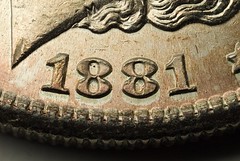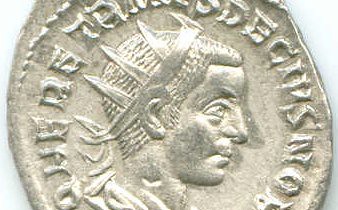
PREV ARTICLE
NEXT ARTICLE
FULL ISSUE
PREV FULL ISSUE
MORE ON NEGATIVE SHADOW AND SURFACE DISPLACEMENTRegarding negative shadow and surface displacement toning effects, Ron Thompson writes: I thought I would add my two cents worth on the discussion. I don't think it is an either or situation, I think both Dick Johnson and Pete Smith are right. I thought I would add my two cents worth on the discussion. I don't think it is an either or situation, I think both Dick Johnson and Pete Smith are right. First, I believe the big central voids in the dies are filled and then, as the pressure continues, the metal continues to flow to fill the last voids at the extremes. This would be the highest points as well as the edges. If Dick has any process sets I sure he can confirm that some of the last areas to be filled are the edges. If too much pressure is applied the metal flows out of the joint between the dies and the collar and we get the wire rim effect. To me, none of this really explains the negative shadow effect. My guess is that the higher areas (the numbers, letters etc) and the raised rim protect that lower narrow surface area from exposure, sort of like sunglasses protect the areas around the eyes from sunburn. However, while that may somewhat explain it, that doesn't explain the lack of toning due to exposure to the air. There may be some micro electrostatic or magnetic field created by the final flow of the metal between the small low area and the surrounding high points that in essence repels oxidizing particles and this field may be protected by the high areas on either side of it. Anyway, it certainly is interesting. In his March 7th blog A Gift For Polydektes, Ed Snible referenced Dick Johnson's E-Sylum submission on this effect. He writes: This effect reminds me greatly of an effect on Roman coins discussed on Moneta-L back in 2004. The most detailed explanation on Moneta-L came from a post by Robert Kokotailo of Calgary coin. I wonder if this is the same effect?  I'm glad to have a name for it! (If it is the same phenomenon.) The name most popular on Moneta-L was 'ghosting', which is also a technical term in numismatics for clashed die errors that leave a 'ghost' of the type on one side upon the other. Ed included in his blog the above Roman coin image from Warren Esty's web page. -Editor Wayne Homren, Editor The Numismatic Bibliomania Society is a non-profit organization promoting numismatic literature. See our web site at coinbooks.org. To submit items for publication in The E-Sylum, write to the Editor at this address: whomren@gmail.com To subscribe go to: https://my.binhost.com/lists/listinfo/esylum All Rights Reserved. NBS Home Page Contact the NBS webmaster 
|